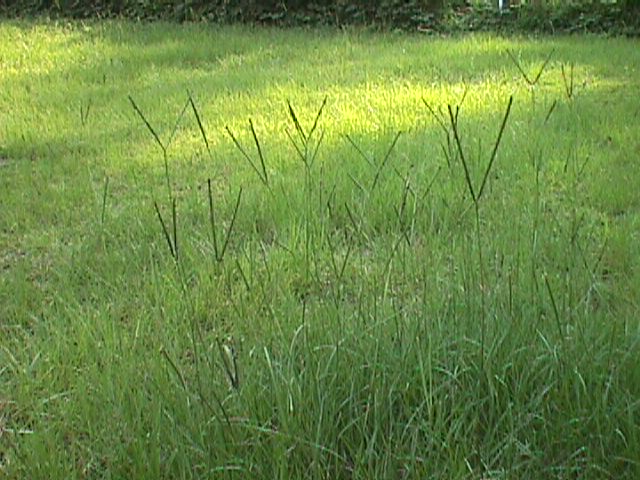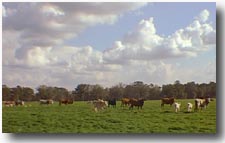Bahiagrass

Common
Name:
Bahia Grass
Family
Name:
Poaceae
Scientific
Name:
Paspalum
notatum
Origin:
Argentina, Brazil, Uruguay, Paraguay.
Description:
Perennial. Spreads by rhizomes and seed,
forms a dens sod.
Very aggressive. Deep rooted. Grows 12-20 inches tall. Bahiagrass grows
reaching 100 cm high (about 40 inches)
Establishment:
Seed are planteed at 15 to 20 Ib/A in March or April.
Fertilization:
Very tolerant of Low fertility and soil acidity.
Seasonal
Production: April- October(warm season
grass)
Distribution: Bahia
grass is considered to be indigenous to southern Brazil and the Americns. It is
Now distributed throughtout the southern USA,
Central and South America, part of Australia, Asia and Africa.

Grazing:
Bahiagrass must
be closely grazed or cipped to keep it tender and succulent for good
quality. When bahiagrass has grown 8-10 inches
tall, it is touhg, low
quality, and unpalatable.
Bahiagrass
such as Pensacola has the
maximum N rates recommended are about 100-200 kg N/ha (90-178 lb/ac).
Phosphorus
applications
increase tillering and yields.
Potassium with N and P can increase
DM yields and digestibility. The FAO reports bahia grass responding well to
10-12 kg/ha (9-11 lb/ac) copper in poor soil. Bahia grass has good salt
tolerance. It can withstand up to 4,500 ppm NaCl in irrigation water. Higher
salinity
(9,000-27,000 ppm NaCl) reduced photosynthesis and transpiration but has
little effect on respiration. Also the animal production on Bahia grass is
acceptable: crude protein is about 14%, with seasonal fluctuations; total
dry matter digestibility ranges from 40-53%.
Management:
Best used
for pasture. Close grazing is desirable. Overseed with winter annuals if
desired.

Recommended
Varieties:
·
“Pensacola” :The most plentiful varieties in
Mississippi is the "Pensacola" of bahiagrass. It has ability to grow on poor
soil and excllent seed production and it more widely planted than other
varieties.
·
"Tifton
9" bahiagrass, a larger growing selection of Pensacola bahiagrass, was developed
by Glenn Burton at the Coastal Plain Experiment Station, Tifton, Georgia. It was
released in March 1987 by the USDA-ARS and the University of Georgia. Tifton 9
is reported to have similar digestibility but stronger seedling vigor than
Pensacola bahiagrass.
·
"Argentine"
is a broadleaf variety, with seeding and spreading characteristics similar to
Pensacola, but it is usually not as productive as Pensacola. Argentine is better
adapted to the fairly well-drained bottom soils that maintain good moisture
during the summer and is the highest quality of all the bahiagrass varieties. It
has considerable resistance to leaf diseases but is easily damaged by hard
freezes.
Growth
Curves:
April- October. The figure a down compare the Bahia with other warm
season grasses.

Legally
labeled forage herbicides:
Bahiagrass
is tolerant to the broadleaf weed herbicides. Spray when the weeds are young.
Seedling can be subject to wed competiton. Planting in a clean seedbed
is recommended.(FAO). No major pests.
Links:
http://www.fao.org/WAICENT/FAOINFO/AGRICULT/AGP/AGPC/doc/pasture/Mainmenu.htm
http://www.noble.org/imagegallery/grasshtml/Bahiagrass.html
http://www.hort.purdue.edu/newcrop/Crops/Bahiagrass.html
REFERENCES:
Cruz AF;
Ishii T; Kadoya K. 2000. Distribution of vesicular-arbuscular mycorrhizal hyphae
in the rhizospheres of trifoliate orange and bahia grass seedlings under an
intercropping system. JOURNAL OF THE JAPANESE SOCIETY FOR HORTICULTURAL SCIENCE.
69(3):237-242.
Findlay
Pate, Rob Kalmbacher, and Frank Martin.2000. Evaluating breeding seasons for
cows grazing winter range and bahiagrass. Journal of range
management. Volume 53:390–394
Baki,
B.B., Ipon, I.B., & Chen, C.P., 1992. Paspalum notatum Fluegge. In: ’t
Mannetje, L. & Jones, R.M. (Editors): Plant Resources of South-East Asia No
4. Forages. Pudoc-DLO, Wageningen, the Netherlands. pp.
181-183.
![]()